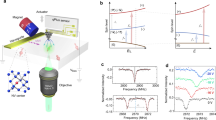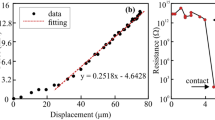Abstract
Because materials consist of positive nuclei and negative electrons, electric potentials are omnipresent at the atomic scale. However, due to the long range of the Coulomb interaction, large-scale structures completely outshine small ones. This makes the isolation and quantification of the electric potentials that originate from nanoscale objects such as atoms or molecules very challenging. Here we report a non-contact scanning probe technique that addresses this challenge. It exploits a quantum dot sensor and the joint electrostatic screening by tip and surface, thus enabling quantitative surface potential imaging across all relevant length scales down to single atoms. We apply the technique to the characterization of a nanostructured surface, thereby extracting workfunction changes and dipole moments for important reference systems. This authenticates the method as a versatile tool to study the building blocks of materials and devices down to the atomic scale.
This is a preview of subscription content, access via your institution
Access options
Access Nature and 54 other Nature Portfolio journals
Get Nature+, our best-value online-access subscription
$29.99 / 30 days
cancel any time
Subscribe to this journal
Receive 12 print issues and online access
$259.00 per year
only $21.58 per issue
Buy this article
- Purchase on Springer Link
- Instant access to full article PDF
Prices may be subject to local taxes which are calculated during checkout




Similar content being viewed by others
Code availability
The custom code that was used for the deconvolution in this study is available from the corresponding author upon reasonable request.
References
He, Z. et al. Enhanced power-conversion efficiency in polymer solar cells using an inverted device structure. Nat. Photon. 6, 593–597 (2012).
Tung, R. T. The physics and chemistry of the Schottky barrier height. Appl. Phys. Rev. 1, 011304 (2014).
Chuang, C.-H. M., Brown, P. R., Bulović, V. & Bawendi, M. G. Improved performance and stability in quantum dot solar cells through band alignment engineering. Nat. Mater. 13, 796–801 (2014).
Fuchs, F., Caffy, F., Demadrille, R., Mélin, T. & Grévin, B. High-resolution kelvin probe force microscopy imaging of interface dipoles and photogenerated charges in organic donor–acceptor photovoltaic blends. ACS Nano 10, 739–746 (2016).
Courtland, R. Moore’s law’s next step: 10 nanometers. IEEE Spectrum 54, 52–53 (2017).
Fuechsle, M. et al. A single-atom transistor. Nat. Nanotechnol. 7, 242–246 (2012).
Lin, J. et al. Flexible metallic nanowires with self-adaptive contacts to semiconducting transition-metal dichalcogenide monolayers. Nat. Nanotechnol. 9, 436–442 (2014).
Xiang, D., Wang, X., Jia, C., Lee, T. & Guo, X. Molecular-scale electronics: from concept to function. Chem. Rev. 116, 4318–4440 (2016).
de Boer, B., Hadipour, A., Mandoc, M. M., van Woudenbergh, T. & Blom, P. W. M. Tuning of metal work functions with self-assembled monolayers. Adv. Mater. 17, 621–625 (2005).
Watson, J. D. & Crick, F. H. C. Molecular structure of nucleic acids. Nature 171, 737–738 (1953).
Moreira, I. S., Fernandes, P. A. & Ramos, M. J. Hot spots—a review of the protein–protein interface determinant amino-acid residues. Proteins 86, 803–812 (2007).
Warshel, A. et al. Electrostatic basis for enzyme catalysis. Chem. Rev. 106, 3210–3235 (2006).
Zerweck, U., Loppacher, C., Otto, T., Grafström, S. & Eng, L. M. Accuracy and resolution limits of kelvin probe force microscopy. Phys. Rev. B 71, 125424 (2005).
Baier, R., Leendertz, C., Lux-Steiner, M. C. & Sadewasser, S. Toward quantitative kelvin probe force microscopy of nanoscale potential distributions. Phys. Rev. B 85, 165436 (2012).
Musumeci, C., Liscio, A., Palermo, V. & Samorì, P. Electronic characterization of supramolecular materials at the nanoscale by conductive atomic force and kelvin probe force microscopies. Mater. Today 17, 504–517 (2014).
Söngen, H. et al. The weight function for charges—a rigorous theoretical concept for kelvin probe force microscopy. J. Appl. Phys. 119, 025304 (2016).
Gross, L. et al. Measuring the charge state of an adatom with noncontact atomic force microscopy. Science 324, 1428–1431 (2009).
Sadewasser, S. et al. New insights on atomic-resolution frequency-modulation kelvin-probe force-microscopy imaging of semiconductors. Phys. Rev. Lett. 103, 266103 (2009).
Schuler, B. et al. Contrast formation in kelvin probe force microscopy of single pi-conjugated molecules. Nano Lett. 14, 3342–3346 (2014).
Albrecht, F. et al. Probing charges on the atomic scale by means of atomic force microscopy. Phys. Rev. Lett. 115, 076101 (2015).
Hapala, P. et al. Mapping the electrostatic force of single molecules from high-resolution scanning probe images. Nat. Commun. 7, 11560 (2016).
Lee, J., Tallarida, N., Chen, X., Jensen, L. & Apkarian, V. A. Microscopy with a single-molecule scanning electrometer. Sci. Adv. 4, eaat5472 (2018).
Fournier, N., Wagner, C., Weiss, C., Temirov, R. & Tautz, F. S. Force-controlled lifting of molecular wires. Phys. Rev. B 84, 035435 (2011).
Wagner, C., Fournier, N., Tautz, F. S. & Temirov, R. Measurement of the binding energies of the organic-metal perylene-teracarboxylic-dianhydride/Au(111) bonds by molecular manipulation using an atomic force microscope. Phys. Rev. Lett. 109, 076102 (2012).
Wagner, C. et al. Scanning quantum dot microscopy. Phys. Rev. Lett. 115, 026101 (2015).
Green, M. F. B. et al. Scanning quantum dot microscopy: a quantitative method to measure local electrostatic potential near surfaces. Jpn J. Appl. Phys. 55, 08NA04 (2016).
Maiworm, M., Wagner, C., Temirov, R., Tautz, F. S. & Findeisen, R. Two-degree-of-freedom control combining machine learning and extremum seeking for fast scanning quantum dot microscopy. In American Control Conference (ACC) 4360–4366 (IEEE, 2018).
Likharev, K. Single-electron devices and their applications. Proc. IEEE 87, 606–632 (1999).
Jackson, J. D. Classical Electrodynamics 3 edn (Wiley, 1999).
Wagner, C. & Tautz, F. S. The theory of scanning quantum dot microscopy. Preprint at https://arxiv.org/pdf/1905.06153 (2019)
Stomp, R. et al. Detection of single-electron charging in an individual InAs quantum dot by noncontact atomic-force microscopy. Phys. Rev. Lett. 94, 056802 (2005).
Miyahara, Y., Roy-Gobeil, A. & Grutter, P. Quantum state readout of individual quantum dots by electrostatic force detection. Nanotechnology 28, 064001 (2017).
Temirov, R. et al. Molecular model of a quantum dot beyond the constant interaction approximation. Phys. Rev. Lett. 120, 206801 (2018).
Tautz, F. S. Structure and bonding of large aromatic molecules on noble metal surfaces: the example of PTCDA. Prog. Surf. Sci. 82, 479–520 (2007).
Zou, Y. et al. Chemical bonding of PTCDA on Ag surfaces and the formation of interface states. Surf. Sci. 600, 1240–1251 (2006).
Kawabe, E. et al. A role of metal d-band in the interfacial electronic structure at organic/metal interface: PTCDA on Au, Ag and Cu. Org. Electron. 9, 783–789 (2008).
Duhm, S. et al. PTCDA on Au(111), Ag(111) and Cu(111): correlation of interface charge transfer to bonding distance. Org. Electron. 9, 111–118 (2008).
Ferri, N., DiStasio, R. A. Jr., Ambrosetti, A., Car, R. & Tkatchenko, A. Electronic properties of molecules and surfaces with a self-consistent interatomic van der Waals density functional. Phys. Rev. Lett. 114, 176802 (2015).
Ruiz, V. G., Liu, W., Zojer, E., Scheffler, M. & Tkatchenko, A. Density-functional theory with screened van der Waals interactions for the modeling of hybrid inorganic–organic systems. Phys. Rev. Lett. 108, 146103 (2012).
Perdew, J. P., Burke, K. & Ernzerhof, M. Generalized gradient approximation made simple. Phys. Rev. Lett. 77, 3865–3868 (1996).
Kellogg, O. D. Foundations of Potential Theory (Springer, 1929).
Pumplin, J. Application of Sommerfeld–Watson transformation to an electrostatics problem. Am. J. Phys. 37, 737 (1969).
Lan, F., Jiang, M., Tao, Q., Wei, F. & Li, G. Reconstruction of kelvin probe force microscopy image with experimentally calibrated point spread function. Rev. Sci. Instrum. 88, 033704 (2017).
Esat, T., Friedrich, N., Tautz, F. S. & Temirov, R. A standing molecule as a single-electron field emitter. Nature 558, 573–576 (2018).
Schulman, J. H. & Hughes, A. H. On the surface potentials of unimolecular films. Part IV. The effect of the underlying solution and transition phenomena in the film. Proc. R. Soc. Lond. 138, 430–450 (1932).
Gross, L., Mohn, F., Moll, N., Liljeroth, P. & Meyer, G. The chemical structure of a molecule resolved by atomic force microscopy. Science 325, 1110–1114 (2009).
Wagner, C. & Temirov, R. Tunnelling junctions with additional degrees of freedom: an extended toolbox of scanning probe microscopy. Prog. Surf. Sci. 90, 194–222 (2015).
Schneiderbauer, M., Emmrich, M., Weymouth, A. J. & Giessibl, F. J. CO tip functionalization inverts atomic force microscopy contrast via short-range electrostatic forces. Phys. Rev. Lett. 112, 166102 (2014).
Schwarz, A., Köhler, A., Grenz, J. & Wiesendanger, R. Detecting the dipole moment of a single carbon monoxide molecule. Appl. Phys. Lett. 105, 011606 (2014).
van der Lit, J., Di Cicco, F., Hapala, P., Jelinek, P. & Swart, I. Submolecular resolution imaging of molecules by atomic force microscopy: the influence of the electrostatic force. Phys. Rev. Lett. 116, 096102 (2016).
Feibelman, P. J. et al. The CO/Pt(111) puzzle. J. Phys. Chem. B 105, 4018–4025 (2001).
Ren, X., Rinke, P. & Scheffler, M. Exploring the random phase approximation: application to CO adsorbed on Cu(111). Phys. Rev. B 80, 045402 (2009).
Kraft, A. et al. Lateral adsorption geometry and site-specific electronic structure of a large organic chemisorbate on a metal surface. Phys. Rev. B 74, 041402 (2006).
Willenbockel, M. et al. The interplay between interface structure, energy level alignment and chemical bonding strength at organic–metal interfaces. Phys. Chem. Chem. Phys. 17, 1530 (2015).
Repp, J., Meyer, G. & Rieder, K. H. Snell’s law for surface electrons: refraction of an electron gas imaged in real space. Phys. Rev. Lett. 92, 036803 (2004).
Ariyur, K. B. & Krstić, M. Real-Time Optimization by Extremum-Seeking Control (Wiley, 2003).
Acknowledgements
C.W. acknowledges funding through the European Research Council (ERC-StG 757634 ‘CM3’). A.T. and N.F. acknowledge funding by DFG-SFB 951 (project A10). F.S.T. acknowledges funding by DFG-SFB 1083 (project A12).
Author information
Authors and Affiliations
Contributions
C.W., R.T. and F.S.T. conceived and designed this research. M.F.B.G., P.L., T.E., N.Fr. and M.M. performed the experiments, C.W. and M.F.B.G. analysed the data. M.M. and R.F. designed and provided the feedback controller, N.Fe. and A.T. conducted the DFT simulations. C.W. and F.S.T. interpreted the data, developed the theory of SQDM imaging and wrote the paper.
Corresponding author
Ethics declarations
Competing interests
The authors declare no competing interests.
Additional information
Publisher’s note: Springer Nature remains neutral with regard to jurisdictional claims in published maps and institutional affiliations.
Supplementary information
Supplementary Information
Supplementary Figs. 1,2, Supplementary references 1,2
Rights and permissions
About this article
Cite this article
Wagner, C., Green, M.F.B., Maiworm, M. et al. Quantitative imaging of electric surface potentials with single-atom sensitivity. Nat. Mater. 18, 853–859 (2019). https://doi.org/10.1038/s41563-019-0382-8
Received:
Accepted:
Published:
Issue Date:
DOI: https://doi.org/10.1038/s41563-019-0382-8
This article is cited by
-
Electric polarization near vortices in the extended Kitaev model
npj Quantum Materials (2024)
-
Electrostatic potentials of atomic nanostructures at metal surfaces quantified by scanning quantum dot microscopy
Nature Communications (2024)
-
Perspective: nanoscale electric sensing and imaging based on quantum sensors
Quantum Frontiers (2023)
-
Polarons in materials
Nature Reviews Materials (2021)
-
Electric potentials at the atomic scale
Nature Materials (2019)



